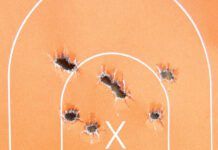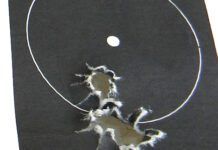The evaluation of tactical or military-style carbines chambered for 22 LR doesnt come as a surprise to our readers, whove been asking for a story on the topic for months. But we admit were surprised that the production of rimfire rifles in full-size carbine trim is such a big trend. So many different models are currently available or on someones drawing board, its going to take two or three more articles to cover the entire category. So lets get started.
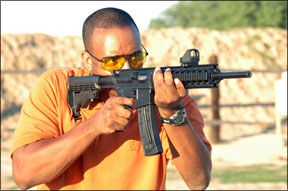
In this rimfire test we will look at two AR-15 derivatives and another carbine that more closely resembled a 1941 Russian machine gun. Our test guns were the Ruger SR-22R No. 1226 22 LR, $625; Smith & Wessons M&P 15-22 No. 811030 22 LR, $569; and the Legacy Sports Puma Wildcat PPS2250S 22 LR, $550. Certainly, training was the most obvious reason for our test guns to be built-but we wanted to know if they were fun, too.
How we tested was determined by the facility of each carbine to support open sights and/or a scope. The Legacy Puma was fit with open sights and a grooved rail machined into the receiver. The Ruger SR-22 and the Smith & Wesson M&P 15-22 each supplied rail support for mounting a scope or a set of clamp-on sights. A complete set of sights were supplied with the Smith & Wesson. But the Ruger was shipped with only a Picatinny rail atop the receiver. Before we could finish dialing up www.yankeehillmachine.com to order a set of AR-15 sights to be mounted on to the Ruger SR-22, we decided instead to use the Smith & Wesson-supplied sights and put them on the Ruger for recording shots of record from the 25-yard line. The accuracy totals would be more head to head, we reasoned, and wed save $100. Just factor the lack of sights into your buying decision if you go with the Ruger.
We also mounted a scope on each carbine and collected accuracy data from the 50-yard bench. For this test we fired only the ammunition that proved most accurate. Our test rounds were Federal Champion 40-grain solids and Federals 36-grain hollowpoint Value Pack ammunition. But it was our third choice that turned out to be the sole ammunition utilized for our 50-yard session. The 40-grain lead roundnose CCI Green Tag ammunition was judged superior in all three guns. However, performance was very close regardless of gun or ammunition. That we were forced to split hairs to determine which gun was more accurate says a lot about the guns, and we might add, the category itself.
For our 50-yard session we mounted a scope on each rifle. In the process we determined that one advantage to these guns was they afforded an inexpensive way to try out different accessories and master new techniques. We had with us some unusual devices, such as Insights MRDS mil-spec dot scope and Leupolds Mark 4 3.5-10X40mm LR/T scope. The MRDS was an upgraded version of a recreational design that offered improved windage and elevation adjustments plus an on/off switch. We wanted to know how well it functioned. The Leupold scope was used in an earlier test (November 2008). The letters LR/T signify illuminated crosshairs plotted as a Tactical Milling Reticle. This means the hash marks seen on the crosshairs can be used as holdover points as they apply to different-caliber ammunition and bullet weights. In addition, the reticle can be used as a grid to mathematically compute changes in elevation settings. This is called ranging. For the limited purposes of our tests the two most important features were the overall layout of its unique reticle. Approximately the outer half length of each crosshair was wide and bold. The inner lines both up and down were fine crosshairs, but the point at which the they met was left empty. Near targets are to be taken with the eyes somewhat relaxed to allow for a manner of wide-angle focus placing the target inside the bracket of the dark crosshairs. To record our 50-yard accuracy data we narrowed our vision to the void at the center of the reticle. The opportunity to perfect techniques necessary for using either the MRDS or the Leupold LR/T scopes effectively, while shooting inexpensive rounds of 22 LR ammunition, was one of the reasons we would own a rimfire carbine like these.
Our targets for the long-range session were Caldwells 12-inch Sight-in Target with Orange Peel capability. This was a 1-foot square with four circles surrounding a diamond. We liked the Orange Peel feature because hits were highlighted with an orange ring, but the hits didnt obliterate the original point of aim. Roger Eckstine handmade the 25-yard target, the Reckstine Sight-In Target, to help the shooters visually bracket the sight picture, placing the tip of the front sight upon the center ring. High-volume work was spent shooting at Caldwellss Shooting Gallery-a great toy for high-capacity rimfire weapons. The $280 Shooting Gallery is a self-resetting, self-contained moving
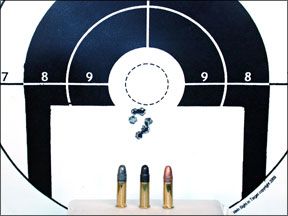
target system. It allowed us to “hull” without tiresome target changes.
Lets find out how each gun performed.
Ruger SR-22R No. 1226 22 LR, $625
The Ruger SR-22 is offered in two models. The SR-22SC utilizes a fixed stock that produces an overall length of about 34.3 inches. Our model SR-22R had an adjustable stock, so length of pull varied from about 10.5 inches to 13.5 inches. With the stock fully to the rear, the SR-22 appeared to be longer than its maximum overall length of 36 inches. The 16.12-inch barrel was extended by an elongated birdcage-style flash hider. We think the aluminum handguard also contributed to enlarging its visual presence. The handguard was solidly fixed to the receiver. The barrel was connected to the action, and at rest it lay upon a polymer bed inside the handguard that acted as a keep for the forward sling stud. Floating inside the handguard, the barrel could be moved around by hand.
The receiver was flat on each side, and the upper section was milled to include a Picatinny rail that was perched approximately 1.5 inches above the bore. The handguard was ventilated with wide circles located at points 2, 4, 8, and 10 oclock. The handguard was drilled and tapped to accommodate additional rails at 12, 3, 6, and 9 oclock. The parts necessary to take advantage of the drilled and tapped handguard were found on www.shopruger.com. We entered the sidebar “Departments,” clicked on “Tactical,” and then on “Accessories.” The $40 top rail extends the flat top to the forward tip of the handguard. There was also a $20 short top rail that applied 3 inches of Picatinny rail to the forward edge of the handguard. This is the part we chose for attaching the front sight assembly. We would prefer that Ruger ship the SR-22 models with the short top rail in place. It would add little to cost and at least provide a mechanism for mounting a front sight. Short side and bottom rails ($15) were also available.
The buttstock on the SR-22 was the standard polymer six-position adjustable design. The grip, however, was a Hogue rubber pistol grip, which we liked. The trigger guard was polymer, and it was not hinged at the bottom. The lower strap of the trigger guard on a true AR is designed to swing away to make more room for a gloved trigger finger.
Perhaps the SR-22 appears to be longer than it actually is because missing was the vertical line of the AR-style magazine. This was because the SR-22 fed from Rugers 10-round rotary magazine. In fact, this is where all illusion comes to an end. The truth is that the Ruger SR-22 is actually a Ruger 10/22. If your purpose for buying an SR-22 is to train for shooting an AR-15, then there are limitations to the SR-22. The magazine release was an extended vertical lever, not a pushbutton on the right-hand side of the receiver. The safety was a crossbolt design operated from the upper rear corner of the trigger guard, instead of a switch operated with the right-hand thumb.
The SR-22 may not offer the opportunity to train for AR-15 operational features, but it does have other characteristics of considerable value. The SR-22 weighed in almost 2 pounds heavier than our other test carbines. Thats just ounces less than the 223 Remington patrol carbines we tested in the October 2007 issue of Gun Tests. Could one argue that a lighter replica offers more realism because felt recoil would be greater? No, 22 LR ammunition simply does not present enough blast to make recoil control an issue. Perhaps the strongest attribute of the SR-22 as a training weapon is the fact that its weight offers the student the actual feeling of handling a full-size weapon.
The 10/22 platform is a proven design capable of high performance with relatively little maintenance. But disassembly of the SR-22 was much more complicated than an AR-15. Takedown for basic maintenance required removing the handguard and a takedown screw found on the bottom side of the receiver forward of the magazine well. Some details of the process were exacting. To lift the barrel-receiver assembly from the stock, the shooter must move the safety to the middle position. Also, the receiver cross pins and bolt-stop pins must be held in place. Removing the bolt required drifting the bolt stop pin loose, and according to the manual, some deft handling is required to free it from the receiver.
At the range we discovered that the SR-22 cycled quickly and soaked up recoil. No feeding problems
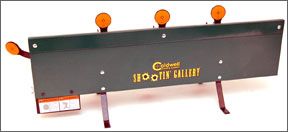
were encountered, and with open sights installed we were able to land sub-1-inch groups from the 25-yard line with each choice of ammunition. Federals Value Pack ammunition delivered groups ranging from 0.8 inch on the Reckstine Sight-In Target to five shots measuring 1.2 inches across. Federal Champion ammunition delivered a spread of 0.6 inch to 1.1 inches. The CCI Green Tag rounds varied less, with the largest group measuring 0.9 inch across and a best single group of 0.6 inch in width. With the Leupold scope in place, we nearly duplicated these results. The SR-22 posted Green Tag rounds in groups of 0.8 inch to 1.1 inches across.
Our Team Said: It is not hard to find loyal advocates of both the Ruger 10/22 and the AR-15 designs. Putting the two systems together is bound to be a success. If you ever wanted to customize the stock of a 10/22, the adjustability offered by the SR-22 should satisfy your needs as well as other members of the family at the same time. The SR-22 may not be an ideal AR training rifle but it stands on its own as a dedicated sporting rifle.
Smith & Wesson M&P 15-22 No. 811030 22 LR, $569
The first time one sees the Smith & Wesson M&P 15-22 the reaction might sound like this: “What kind of magazine is that?” The see-through relief and load assist lugs are a dead giveaway. But from the left-hand side of the carbine, there is little else that would lead you to believe it was anything but a patrol carbine with A2 sights and Picatinny rails on all four sides of the handguard. However, Smith & Wesson did see fit to leave off the flash hider, and the trigger guard was molded, sans bottom hinge, as one piece with the polymer receiver.
The right-hand side of the carbine showed a shorter ejection port than a centerfire model, but the bolt was worked by the charging handle. Of the replica features, this may have been our favorite overall. The magazine was the approximate size of a 30-rounder, but the magazine held 25 rounds of 22 LR. Residents of encumbered states are offered model number 811031. This is the Compliant version of the 15-22 and its shorter magazine (closer visually to a 20-round AR magazine) holds only 10 rounds.
Owners of an M&P 15-22 will get a full lesson on the AR-15 manual of arms. Here is a list of standard black-gun characteristics: Six-position adjustable buttstock with solid mount sling loop. The pistol grip was bolted into place, not molded with the receiver. The magazine release was right-side only, index-finger operated. The safety was above the grip on the left side. Safety-on was parallel to the bore. The gun was ready to fire when the lever was pointing straight up. The bolt release was another standard AR design. Each of these parts looked like they could be fit on to any other AR-15.
All guns work better when they are maintained, and the easier it is to clean and lubricate a weapon the more often it will be done. No other semiautomatic rifle or carbine breaks down as easily as an AR-15, and the M&P 15-22 was field-stripped in exactly the same manner. Push inward on the pin located on the left side of the receiver immediately above the grip, and the top end hinged away from the receiver. The bolt and carrier were then pulled out by the charging handle, which separated as the carrier leaves its channel.
The receiver was a flat-top style, with a rail that stretched continuously from the charging handle to the tip of the 10-inch-long polymer handguard. About 5.5 inches of straight-wall barrel was left uncovered. The barrel was medium gauge and fixed rather than free-floated, gaining support via a bushing seated at the very front of the handguard. Sights front and rear were non-folding and held in place by heavy knurled screws. The front unit was the tower style with a square blade that was adjustable for height by
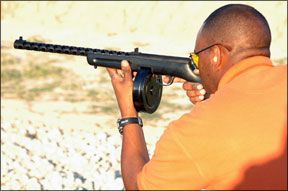
depressing the spring-loaded detent peg and turning the blade. The rear sight was adjustable for windage and elevation, and two apertures of different size could be rotated into place, just like an AR-15 sight. In handling, the M&P 15-22 was considerably lighter than Smith & Wessons 5.56mm M&P models.
From the 25-yard line, the Smith & Wesson M&P 15-22 equaled the Ruger SR-22 when firing two of our three test rounds. Whereas the Federal Champion rounds shot groups that averaged about 1.1 inches across, most of the groups we measured firing our Value Pack rounds were less than 1 inch across. The CCI Green Tag rounds produced groups that measured 0.6 inch, 0.7 inch, and three more groups barely 0.9 inches across. From the 50-yard line, our Green Tag groups ranged from 0.6 and 1.1 inches center to center. There were no malfunctions throughout our test of the M&P 15-22.
Our Team Said: The M&P 15-22 covers all the bases in duplicating the AR-15 experience. That it breaks down much the same as its big brother is another plus above and beyond the true-to-form charging handle, magazine release, etc. Perhaps what we liked best about this carbine was that it offered a cheap day of shooting with a weapon as close to an AR-15 as we could get. The M&P 15-22 was light enough, and thanks to its adjustable stock, ideal for small shooters. The subdued recoil and noise of the rimfire ammunition make it even easier to use the AR platform.
Legacy Sports Puma Wildcat PPS2250S 22 LR, $550
In a review of first impressions the Ruger SR-22 could be seen as a match rifle. We think the Smith & Wesson 15-22 portrayed a patrolmans carbine. The Puma Wildcat, on the other hand, drew an immediate emotional response that was more difficult to pin down. Actually, the design of the gun was not unique.
You dont have to be an expert to spot the Russian PPSh-41 on page 142 of Twentieth Century Small Arms by Chris McNabb (Metro Books, New York), and recognize the similarity. The PPSh-41 was a blowback-operated submachine gun chambered for 7.62M1930 caliber rounds. The PPSh-41 fed from either a 35-round box or 71-round drum magazine. It arrived on the scene in 1941 and followed the design of the PPD series of similar weapons used in the 1930s.
The Puma line of rifles (carbines, to be more exact) are made in Italy by Pietta. Legacy Sports (www.legacysports.com) imports nine different Puma models, with the primary differences being the stocks, either wood or polymer, and the supplied magazine. The least expensive model costs $525 and comes with a black polymer stock and 10-round magazine. The most expensive model is also polymer stocked but ships with both a 10-round and a 30-round magazine. Our carbine arrived with a 50-round drum magazine. Legacy sells magazines separately and lists the prices as $50 for the 10-rounder, $74 for the 30-round model, and $105 for the 50-round drum.
The black polymer stock on our carbine was a simple two-sided construction with seam top and bottom. The stock spanned from beneath the first 6 inches of the barrel to the buttplate. The buttstock was hollow. Sling studs were mounted front and rear. The barreled action sat above the stock so that the rear of the action was exposed. Some might recognize its “humpback” profile as being reminiscent of the Browning Automatic Rifle. The top of the receiver offered a 3/8-inch rimfire-groove scope rail. Just ahead of the rail was a fold-up rear sight blade that was windage adjustable by using a small screwdriver. Elevation adjustment was achieved by raising or lowering a plate mounted on the rear sight. The plate featured a V-shaped relief to provide a focal point. One simply loosened the two screws that held it in place and moved the plate up and down to cover or expose the larger notch cut into the main sight blade. Adjustments for elevation could be kept track of thanks to clearly marked calibration lines. A smaller center line could be compared to calibrations on the sight base for changes in windage. This unit was dovetailed into a polymer base that was screwed on to the receiver. The front sight was a one-piece polymer unit screwed on to what we commonly call the heat shield. The heat shield was rigid and machined as one piece with the receiver. Actually, this was referred to as the barrel cover in the owners manual. The barrel was slipped through the heat shield, or rather the barrel cover, and screwed into the action. The tip of the barrel cover was fit with a bushing to support the front of the barrel.
The bolt appeared to be stainless steel, and it worked against a heavy spring. A roller handle was in place. A sheetmetal safety lever was located behind the bolt handle on the right side of the receiver, (forward for fire, rearward for on-safe). The magazine fit into a sizeable notch immediately ahead of the trigger guard. The magazine release was located inside the trigger guard. To drop the magazine the operator pushed forward on the release, which was heavily spring loaded and returned to its original position after each use.
Takedown began with removing the stock from the barrel cover. This was achieved by removing the screw located on the bottom side of the carbine just ahead of the trigger guard. The two screws and the single pin that hold the receiver to the barrel cover were now exposed. Removing them allowed for the barrel and the receiver to be serviced separately.
In terms of operation the Puma was the only weapon in our test that experienced malfunctions. Rounds failed to feed completely into the chamber, and we noticed that lead was being shaved from the bullets. Our first response was to clear and maintain the chamber and surrounding area. This helped keep the gun running, but not entirely. In our opinion we think shaving was not the problem, but rather a symptom. To begin with, the 50-round drum magazine was not the most willing participant. Working against the internal spring we found loading to be difficult. We resolved to load the magazine with 5 or 10 rounds the first time, then more each time to give the spring we were working against a chance to break in. The most we were able to load into the drum at any one time was 30 rounds. But we were able to fire all 30 rounds rapidly without malfunction. This might prompt us to buy the Puma with the smaller magazines for the sake of reliability.
From the bench, the view through the open sights was very clear. Obviously an older design, the front and rear units were technically sound and properly applied. Perhaps this was why we were able to shoot groups measuring about 1.0 inch across or smaller with all three test rounds. Firing the CCI Green Tag we fired one 1.0-inch group then reeled off five-shot groups measuring 0.9, 0.5, 0.7, and 0.6 inches across. Every group we shot with the Federal Champion ammunition was measured as being just a little less or a little more than 1.0 inches across. The Federal Value Pack rounds were delivered in groups ranging from 0.7 to 0.8 inches. With scope in place, our 50-yard groups once again mirrored our 25-yard performance. It seems that each of our carbines was capable of matching 25-yard open sight accuracy with 50-yard groups once a scope was applied.
Our Team Said: We would theorize that magazine integrity was the greatest hindrance to the reliability of the Puma Wildcat. Nevertheless, it turned out to be a lot of fun. We doubt well ever get a chance to shoot a 7.62mm Russian machine gun such as the PPSh-41. Until we do, the Legacy Puma Wildcat may be a facsimile well worth the occasional trouble. This is one of the few rifles we can think of that might sell based solely on visual or emotional appeal. In addition, we found its accuracy to be most rewarding.
0210-RIMFIRE-ACCURACY-CHRONO.pdf
0210-SMITH-WESSON-MP-15-22.pdf




